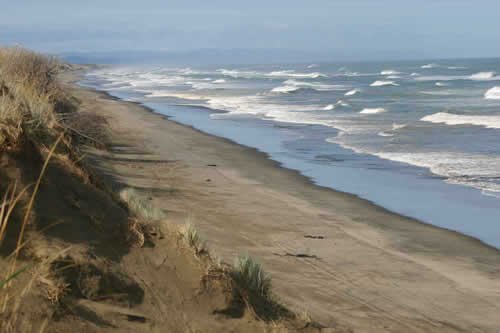Black sand appearing on the shores of the Kaipara Harbour could spell the end of a multi-million dollar marine turbine power project
An ever-increasing flow of black sand appearing on the shores of the Kaipara Harbour could spell the end of a multi-million dollar marine turbine power project for Crest Energy, according to a Kaipara beach historian.
Noel Hilliam is part of a team that researches shipwrecks in the harbour and he says the electronic equipment researchers use have been rendered useless with the sudden influx of the black sand.
“The electrical field’s magnetic conduction attracts iron sand and it wrecks our equipment,” he says.
Crest Energy have plans to develop a marine turbine power resource by setting up 200 submerged turbines at the harbours entrance with an estimated cost of $600m over ten years.
Mr Hilliam believes what happened to his electronic equipment will happen to the marine turbines too, “it will spell the end of the project”.
“It’s not just a major problem for power generation but it’s a natural disaster, as the black sand is heavy and has blanketed the ocean floor, suffocating shellfish” says Mr Hilliam.
“I’ve been on the beach all my life and this is just horrendous really.”
Mr Hilliam says there is a layer of black sand 150mm thick at the harbour’s entrance, at Pouto Peninsula and believes there must be thousands of tonnes of the stuff washing through the harbour.
He says the iron sand is travelling to its destination from two ancient volcanoes located in the Tasman sea just off New Plymouth’s Mt Taranaki.
“We’ve been getting it in small amounts over the last few years but since June its intensity has increased phenomenally.”
The sand dunes out at Pouto now have a blackish tinge to them.”
Kaipara Mayor Neil Tiller told the Dargaville and Districts News that he was aware more black sand had been coming onto the beaches recently.
“My brother in law’s kids went out to the beach to play with their electric cars and the black sand got stuck in the motors and stopped the cars from working.”
“I think this will ring alarm bells for Crest Energy,” says Mr Tiller.
Crest Energy’s director A J Hopkins says he wasn’t aware of black sand coming into the harbour.
He said he had no further comments but confirmed he would take the matter to his advisers for discussion.
Crest Energy has applied for resource consent to construct a marine turbine power generation project in the Kaipara Harbour, for a period of 35 years.
The project comprises up to 200 completely submerged marine turbines with a maximum generating capacity of around 200MW, located near the entrance of the Harbour If Crest Energy proceeds to the construction phase the initial capital requirement is estimated to be approximately NZ$40 million.
Leading energy producer and retailer Todd Energy announced last week it had taken a cornerstone shareholding in tidal energy company Crest.
Iwi group Te Uri O Hau Trust are working with sand extraction groups to monitor the Kaipara Harbour.
Trust services manager Deborah Harding says concern has been raised from community members about the black sand.
“But this hasn’t been followed up with any hard evidence that Te Uri O Hau are aware of.”









1 Comment
Marine generators are designed to be water tight so there is little chance of black sand ever reaching the components within, unlike falling into the motors of children's electric cars run on a beach containing the material. It is to be expected that since the sand contains iron, the suspension of this type of sand in water would affect the sensitivity of electronic equipment, by blocking the gathering of electronic data which passes through the water in the form of electromagnetic waves. The research equipment used for this purpose would not be harmed but the results produced by the modified data would be rendered unusable.
The manufacturing of the rotor blades should be made so as not to be magnetized at the time of production to prevent the attraction of the sand. The rotary movement of the blades would dismiss clinging of the sand to the outer surfaces, if there was any inherent magnetism, except near the point of connection to the shaft where the angular velocity would be slow.
The only real possible effect of such sand might be its abrasive action on the outside of the blades.